“The Current Chapter”
The last time I saw the East Broad Top under steam was October 29th, 2011, during a freak pre-winter blizzard fondly referred to as Snowtober. The storm produced unusually early season snowfall across the northeastern United States, breaking records for total accumulations. In fact, in some cities Halloween was cancelled and children were left without treats. Two months later, the tourist excursion season ended, and the East Broad Top Railroad and Coal Company suspended operations indefinitely. The narrow gauge railroad has been dormant since, their doors locked. Once touted as the oldest operating narrow gauge steam train at its original location in America, water has not boiled inside a locomotive for five years. But I never stopped going back to visit this historic landmark. Face-to-face in the presence of absence; the current chapter.
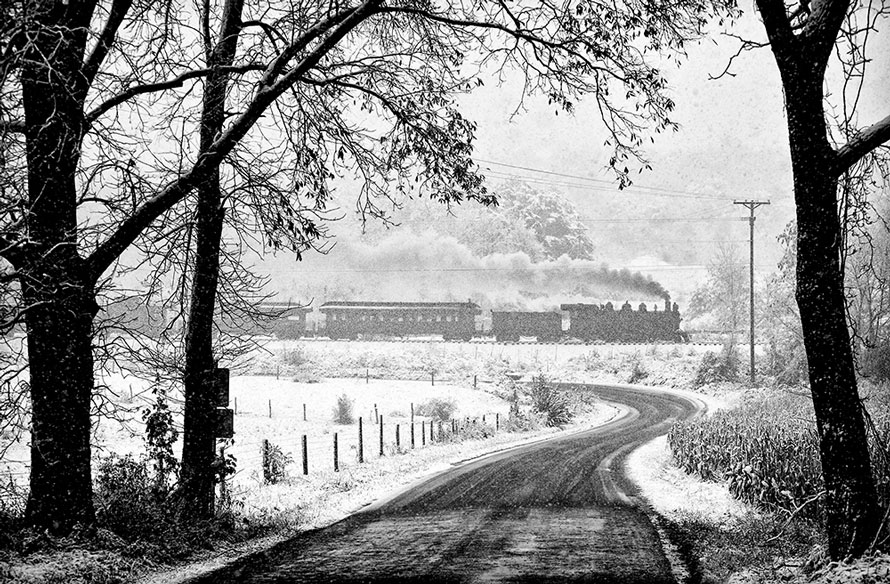
Since its most recent closure, I have been routinely visiting the towns of Orbisonia, Mount Union, Robertsdale, and all points of interest in between. Regardless of season, weather conditions, or time of day, it is my mission to photograph and document the facilities as they exist present day. With permission from EBT management and ownership, access to the railroad complex has been graciously granted to capture photographs of these spectacular scenes.
The absence shows a presence, and the ghosts are there, the images are there, the souls are there.”
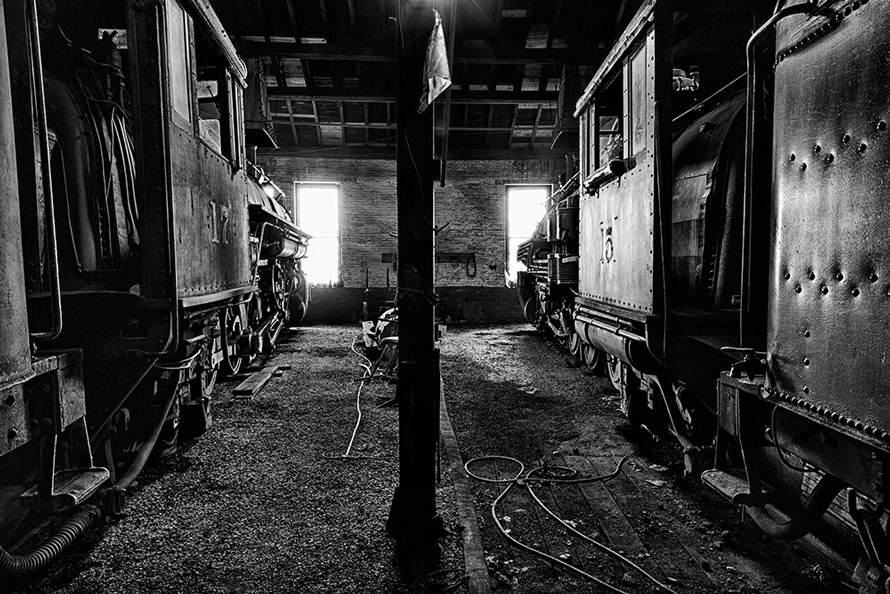
The roundhouse is there, the turntable is there, the locomotives are all there, as is the collection of rolling stock, the backshops, the tracks, and the entire infrastructure. Arguably the most intact and preserved steam railroad in the country, possibly the world, every component of the bygone era of coal and the industrial revolution remains. But there is no operational activity. The silence is deafening and all encompassing. One comes to Orbisonia; it’s empty. You can barely imagine or fathom what is there. But that absence shows a presence, and the ghosts are there, the images are there, the souls are there. The magnitude of what happened is there, even if unseen. It is too big to understand—an artifact that someone held, someone worked on, someone owned; a connection with something from long ago.
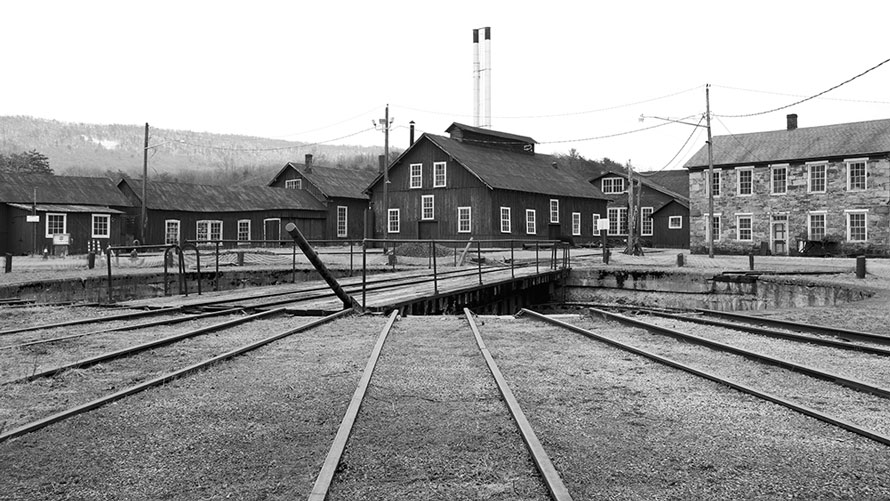
It is the ultimate time machine. Notice the textural details in these images—worn stone and brick walls, patterns and shades of rust, fatigue and failure of steel, distressed wood, faded paint, sagging structures, the tarnish and patina. Nature has clearly taken its toll and made a home within this lonesome landscape. Originally built in the nineteenth century, this once thriving railroad now stands lonely and silent. Locomotives and rolling stock await the day skilled workers might breathe new life into the railroad. A national treasure; a gateway to the past. Still standing, and remembered.
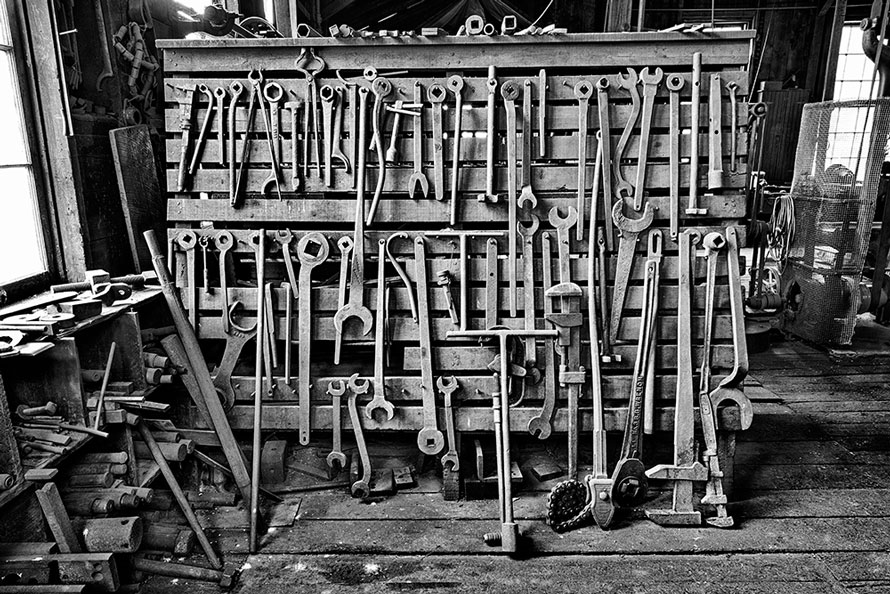
Nestled in the hills of south central Pennsylvania is a complex that time has left behind. When visiting the East Broad Top today, you will find a ghost-like railroad, originally closed over 50 years ago, but never scrapped. Sitting quietly ever since, the EBT is a slice of history that, unlike many other lines, was left as is. Now the same rails that once carried trains of coal peacefully rust in the forest. In this time capsule of American industrial history, you can still find work started over a half century ago waiting patiently for the skilled hands, long gone, to return to the lathes, drills and forges.
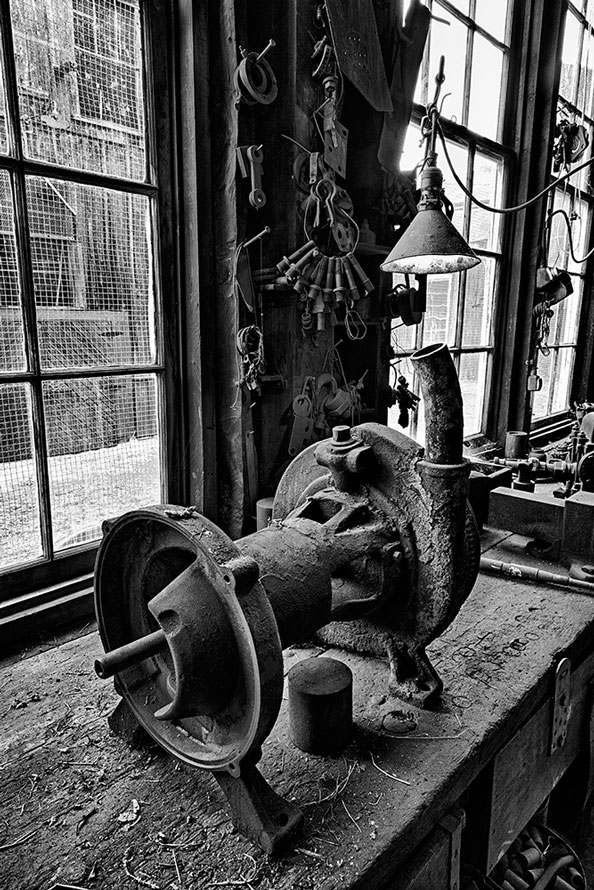
There is no noise other than the wind outside rattling the steel roll-up doors, or the chatter of vintage glass windowpanes.”
Being on the inside is a surreal experience. It’s truly overwhelming; a great privilege and honor. This is hallowed ground, which is rarely trod upon. One can only imagine what it might have been like back in the day for the men who labored within these walls. I am surrounded by machinery that lived a life before me—I’m the youngest object present. When I find myself alone in the roundhouse and shops, the absence of sound is nearly maddening. There is no noise other than the wind outside rattling the steel roll-up doors, or the chatter of vintage glass windowpanes. A heavy coating of dust covers all surfaces and artistic woven cobwebs are in almost every corner. The air is musty and stale. It’s cold and dark. But to the history buff and hard-core steam railfan in me, it is pure paradise. Everywhere I turn, I see beauty. Like the Grand Canyon or Niagara Falls, it’s almost impossible to capture the grandeur and splendor of the East Broad Top. If only I could travel back in time to this much simpler and nostalgic era.
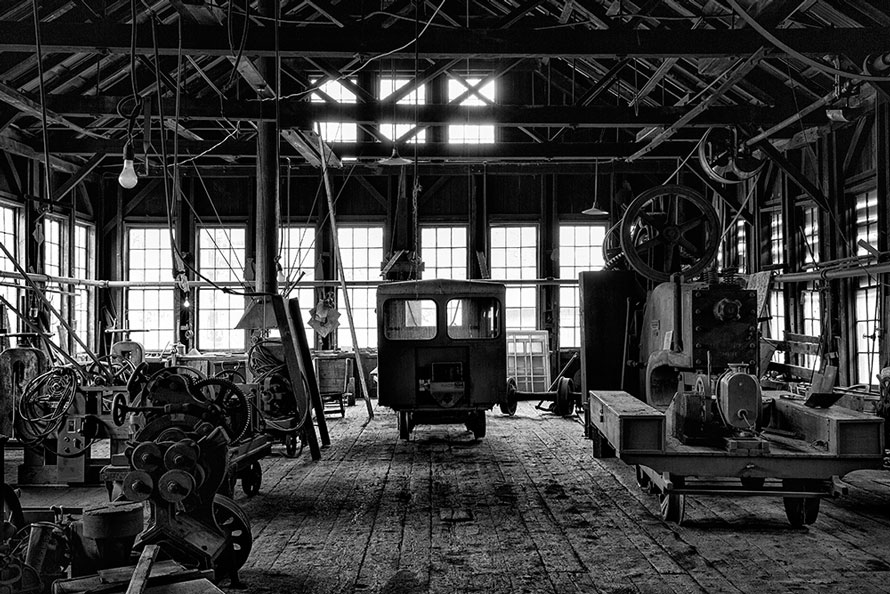
But this is not a story of gloom and doom, despair, loss, or hope abandoned. The Friends of the East Broad Top volunteer their time on weekends throughout the year to stabilize and restore buildings, tracks and rolling stock in Orbisonia and Robertsdale. They monitor the condition of structures, stored trains, and other artifacts, and work to ensure the EBT is well preserved. The Friends promote public awareness of this unique historic site, publish a quarterly magazine and organize meetings and programs for FEBT members, including an annual Fall Reunion, and special public events that celebrate the region and its heritage.
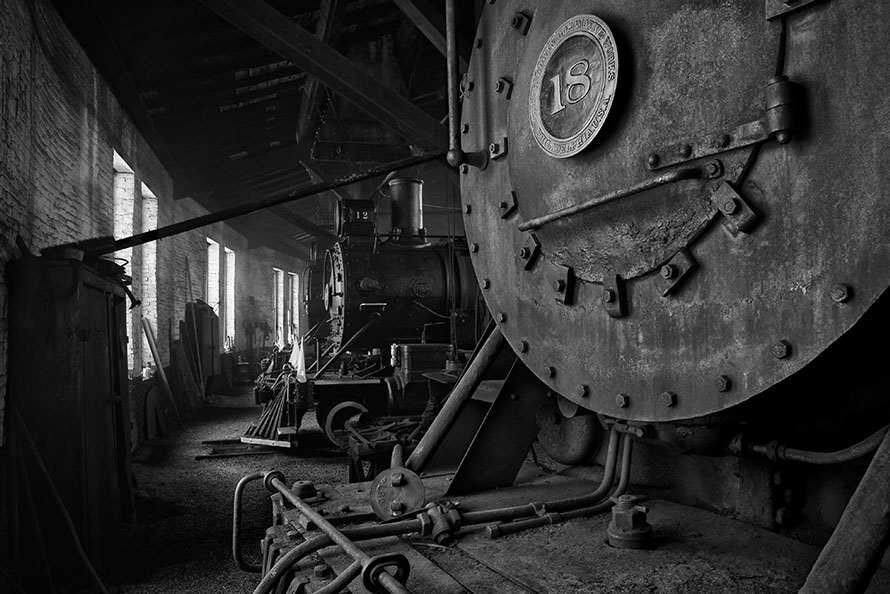
There is also rebirth and reassignment. Hopper cars that once carried coal and rock from the mines in the Robertsdale area through the hub in Orbisonia to the interchange at Mount Union continue to be used elsewhere. The White Pass & Yukon Route in Alaska, the Sumpter Valley Railroad in Oregon, and the Cumbres & Toltec and Durango & Silverton railroads in Colorado have the cars on their active maintenance-of-way rosters. A few still sport their original EBT heralds.
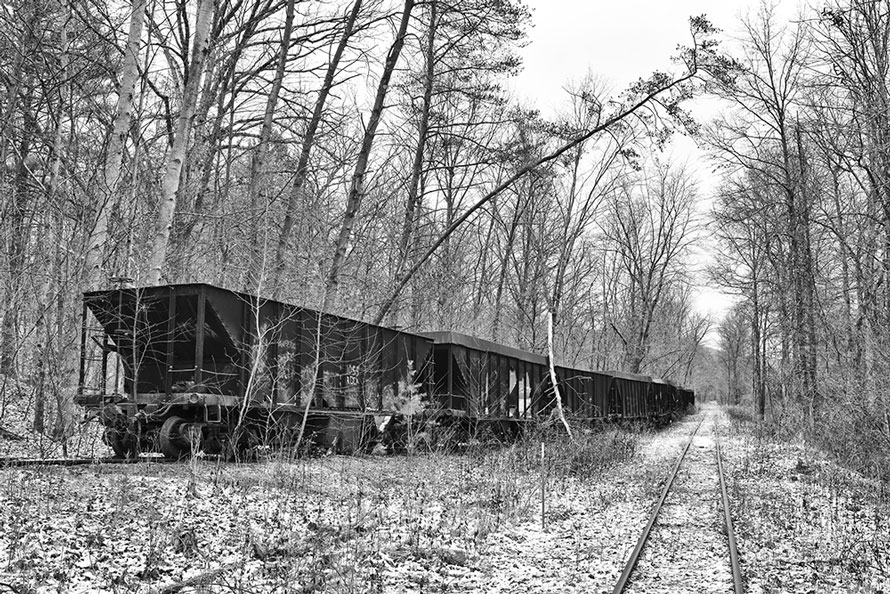
Will the home rails ever see an East Broad Top locomotive run again? It’s a popular question with no definitive answer. I’m an optimist who still sees this glass half full. To this day, the entire facility and collection remains intact and undisturbed. This fact alone is a monumental victory. I am very thankful that the Friends of the East Broad Top actively preserve and restore this link to yesteryear. I’m so grateful that I have had the great pleasure to capture and share these timeless images.
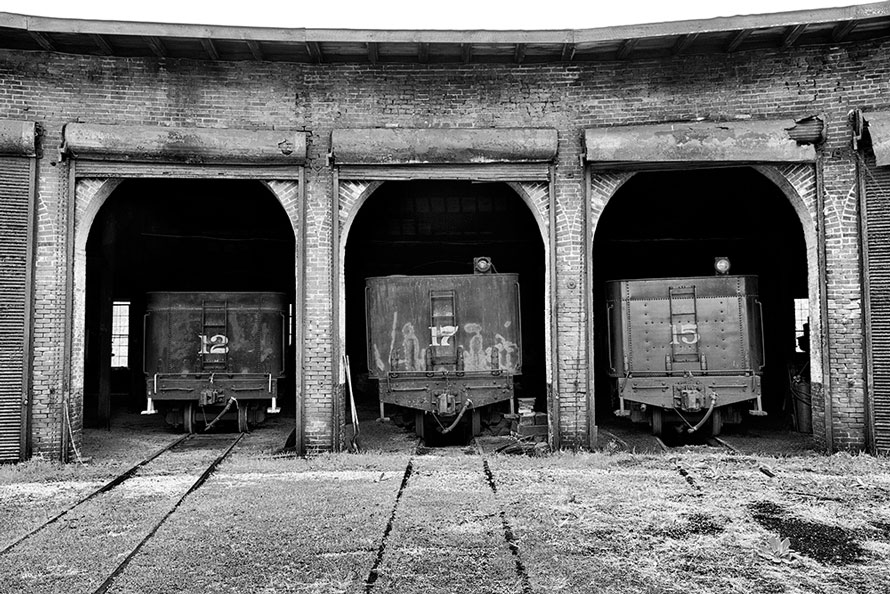
I look forward to when clock hands run backwards – as narrow gauge, smoke billowing trains again traverse the Pennsylvania countryside pulling passenger laden cars. Until then, I will continue my quest in the land that time has ignored with my cameras in hand. It always lures me back . . .
All photos taken between the years of 2011 and 2017
Matthew Malkiewicz – Photographs and text Copyright 2017
Matthew's entire collection of East Broad Top photographs can be viewed on his Lost Tracks of Time website at "East Broad Top Gallery"
Matthew, you are on the path only a few follow.
Dennis, you know me; I struggle to stay on the well-beaten paths…
Very interesting historical write-up of what once was, and is still there, but untouchable.
I especially liked the Black & White photos to add the effect of times gone by, and forgotten.
Keep up the Great work and maybe in due time (hopefully in our lifetime) the EBT will be
brought back to life, like other small railroads.
This one not having to start from scratch to re-build it.
Thank you Val! Stripping away the color enhances the shapes, tones, shadows, highlights, and textures of a photograph – a perfect application for this essay.
What a treasure! Thank you for helping keep the past alive. I’ve shared all over!
E.E., I appreciate you sharing it within your network! And yes this is an incredible treasure in this modern day.
Thanks for sharing your experiences and opportunities with us, Matthew; the more who know about these treasures, and think about them often, the more likely that some sort of salvation will come . . .
Oren, I am so glad you were able to accompany me for one of my recent visits inside. I completely agree with you – making more aware will hopefully offer salvation.
Matthew, Wonderful essay on an important part of narrow gauge history. Further, your images are timeless and bring your editorial to life. It would be great if this helped to stimulate a reborn EBT.
And thank you also Ron for joining me all the way from Wisconsin for a tour inside. I look forward to our next slideshow, when your images will be on display.
My father grew up a stone’s throw from the EBT tracks in Mount Union; regaled in telling tales of the Shade Gap summer picnic trains of his youth, and shared my enthusiasm in Rockhill Furnace as together we rode some of the first trains of the resurrected EBT in 1960. With dad’s sister’s home abutting the EBT right-of-way in Three Springs, my own visits to EBT country were many, both with and without my family. I live in California now, far from the 3-foot rails of the EBT and many years removed from my own last ride there over three decades ago, but an essay and photos like yours bring it all back as though it was yesterday. Thank you so much for sharing. I appreciate it beyond words.
David,
Your comments are heart felt, I appreciate you sharing your experiences! I often say I was born too late; I wish I could have seen what your eyes did, and experienced the EBT in its younger days. I assume you have photos of your ventures in Orbisonia, and hope you treat them as pure gold.
You have frozen time in you images of the EBT. Your essay shows this narrow gauge icon at the turning point between either a future rebirth back to life, or a fatal slide into collapse and oblivion.
Martin: As I mentioned in the article, I’m an optimist that truly believes the EBT will continue to stand the test of time, and will be with us well into the future. Good hearing from you!
Are there fundraising strategies in place moving forward that first protect, maintain and preserve the existing asset (incl the land, taxes, roofs, bricks and mortar etc.); and others that work toward returning steam to the boilers? Volunteers are crucial, money is essential. Are there state or federal funds available? Matthew, please share your story above, leveraging your words and exquisite images, to as many venues possible, support is critical, reach-out to perhaps the Sunday NYT… a one sentence reference to EBT was last printed there in 1988!
Thank you all for your comments left here as well as the emails sent my way. The East Broad Top is my all-time favorite railroad, I want only the very best for it. To this day, visiting is an addiction I cannot break. When the alarm clock goes off at ungodly hours of the morning I can’t get out of bed fast enough. At the end of a long day of shooting I don’t want to leave. It is my photographic personal project; I anticipate my next return.
Matthew
Nice story Matthew and your pictures are just superb! The Friends group is doing a remarkable job keeping the infrastructure stable due to the passion and drive of its members. Without them, much of what you have photographed would have probably succumbed to the elements and time long ago. Unfortunately many of its members are getting older and they will need young blood to keep the flame going at EBT. Beyond maintaining the infrastructure and keeping the story alive, I’m not sure what else they can do to bring back steam. Even though the entire railroad has been put up for sale by the owners, there has been no takers, either private or governmental. The railroads’ remoteness allowed it to operate relatively late as a common carrier, serves to keep it away from the no-gooders, but is also a detriment in bringing in the steady stream of visitors that any future operator would need to sustain it. It boils down to pure economics in the end.
While the future is uncertain for the railroad, we can at least appreciate it for what remains. Your passion for the railroad is apparent in the beautifully composed and emotionally charged images that you have made of the railroad. A true keeper of the flame.
Eric, I appreciate you taking the time to leave a reply. I could not agree more with your first sentence and last paragraph. So thankful that the Friends keep the dream alive for so many of us, and I’m grateful for what remains. Its all still there, some of it deep in the woods partially covered by nature awaiting rediscovery. Let’s get back there again together in the near future! I enjoy viewing the EBT through your visions, photography, and blogs.
Matthew: Fine writing in addition to your fine photography. I’d like to use a brief quote (with credit) in the last of my EBT (Early Locomotives) series for the NG&SL GAZETTE. You have done a great job in what my old boss Wilson Hicks, Picture Editor at LIFE, would call “the perfect integration of words and pictures.”
Thank you Mallory! Your words mean a lot to me. Early on in my photography and train chasing career you were an early influence, especially with your book titled ” Colorful East Broad Top”. That volume is a permanent fixture on my living room coffee table, and has been at my side many times when visiting the EBT as my #1 source of reference.
Hey y’all! Railroads and trains have always been in Matt’s love life. Ever since he was a small boy with a basement designed as though one could transcend into the world of trains I felt he would excel. What I didn’t know was how talented he is with a camera. Wonderful photos! The B&W ones truly impress the world people have forgotten. Keep on 🙋!
Thank you Debbie! Long ago I had the same 35mm film camera as Joe; I would sometimes borrow a lens of his to go out shooting with. I still remember the pizza parties downstairs at your house afterwards showing each other photo prints. Although these photographs are impactful in color, the B&W versions seems to speak more towards the past.
As someone who helps keep one of the most preserved railroads of the west alive day anfter day, this is great. 250miles away from anything in the middle of Nevada, I watched a train leave Ely with 120 people on it yesterday, and it’s not even memorial day weekend yet! The season is just getting started. I know with the right help, work and people the EBT could do the same, because if the right people believe in it, and put their time in, people will see it as a train worth riding.
I first met Eric during my barnstorming years in southwest Colorado, another Mecca for narrow gauge steam. At the time he was with the Durango & Silverton; these days he is the ‘Director of Guest Services’ at the Nevada & Northern Railway Museum in Ely. The NN takes a back seat to no one in regards to preserved steam – I last saw Eric in February during one of the Winter Steam Spectacular weekends. I echo his closing comment, quoting the movie ‘Field of Dreams’, “If you build it, he will come…”
Pretty sure “Snowtober” was 2010, not 2011
James, Matthew can weigh in on this, but according to Wikipedia, “Snowtober” was indeed in 2011 https://en.wikipedia.org/wiki/2011_Halloween_nor%27easter
Edd Fuller, Editor
Edd is correct, Snowtober happened in 2011.
What an interesting write up, Matthew! And once again, the images are absolutely stunning! I will show this to friends.
Thank you Victoria, I’m glad you enjoyed it! I’m doing my best to keep the memories alive, both inside of me and within others. I can’t explain why, but something keeps pulling me back there time and time again.
Beautiful pictures and write up Matthew, I hope all the hard work can save EBT!
Colleen, thanks for your reply. Sometimes I wish the world was black and white as in my photographs –
both melancholy and magnificent at the same time, with a real “life after people” mysteriousness to them.
Yeah! … Couldn’t be more thrilled. You are combining your poetic descriptive story telling talents with your outstanding photography. A new door has opened and can’t wait to see where this continues to blossom. Bravo!
Much appreciated Bo! As a reminder it was you who encouraged me to step out of the comfort zone into uncharted waters and start writing. I will continue my trips to the EBT, collecting content in the form of photographs and experiences for putting to words. Thanks.
Matt, your work at documenting the EBT is an awesome endeavor! Preserving the EBT through your outstanding images excellent writing keeps the spirit of this unique railroad alive and hopefully may ignite the spark to once again see it run. I don’t have to tell you to keep up the great work you’re doing because your own motivation and dedication tells that.
My only visit to an operating EBT was in the summer of 1963 with my parents when I was 10. Even at that young age the railroad became a favorite. I visited The EBT last October for the first time since that 1963 visit and I can see why it keeps you coming back.
I’ll look forward to seeing more of your beautiful work on this national treasure!
Thank you Lou! Compliments like this inspire and motivate me to continue my endeavor. I wish I could have seen all of this in 1963, but then again it probably looked almost identical to current day. You come back east again soon and we’ll meet up and explore the less known hidden little gems I’ve found along the way…
Wonderful article! The essay is intriguing and the photos are enamoring. Really beautiful work, as always! I’ve always enjoyed your work, Matthew, but seeing it here in a succinct essay is truly a treat. I can’t wait to see what else you have in store for us! 🙂
Thank you Tina! Everything here has a story, with each return visit my cameras are listening. I go back again soon – with anticipation and excitement.
Matthew – outstanding (Ansel Adams style) photography and very moving story. Could I have your permission to republish this in the NMRA British Region newsletter that is distributed to members in the United Kingdom who do not have access to the EBT and would love to see your lovely photography and read your carefully crafted words.
Peter, I thank you for the compliment about both my photos and their accompanying story! Yes I would like to collaborate with you for the NMRA newsletter – a great opportunity to share the EBT with your members. See your email inbox to further this discussion.
Matthew